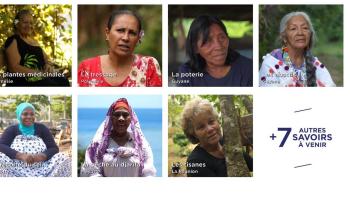 Can you describe AFD’s commitment to the Congo Basin forests?
Can you describe AFD’s commitment to the Congo Basin forests?
Patricia Aubras: Central Africa is the planet’s second largest tropical forest area after the Amazon basin. It is home to 20% of the world’s tropical forests and to unique, very diverse, and still rather unknown biodiversity. Preserving this biodiversity is one of our priorities. A key component of AFD’s regional strategy is devoted to enhancing the value of the region’s ecological heritage. We do this by promoting the development of this common good and thereby helping reach a better balance between the forest’s use and its protection.
Sustainable and equitable management of these forests is a major challenge for the region, as well as for the world as a whole. In the Congo Basin, there is a delicate balance. It is currently undermined by the fragmentation of forest areas due to human exploitation, weakness in how the regulatory frameworks for ecosystem protection are applied, and climate change.
A recent publication in Science illustrates this: the fruit-eating elephants of the Lopé National Park in Gabon are starving to death because the fruit they feed on is almost 80% less abundant than 30 years ago.
As part of our commitment, we advocate the best practices known to date and provide guidance for public policies by supporting responsible and sustainable development of forest areas that helps reconcile nature, climate, and development. Between 2012 and 2021, AFD has committed €260 million to support projects directly linked to the protection of forests and biodiversity in Central Africa through grants, loans, or delegated funds. Over the years, AFD has become a key player in the dialogue among governments, professional organizations, and environmental NGOs.
Is the responsible forest management model supported by AFD currently adapted to defense of these forests?
P.A.: Yes, because the objective of this strategy is to limit the human hold on the forest and to make it sustainable. It consists of supporting operators who undertake to respect a forest management plan that complies with the regulations in force, which means that they contribute to the renewal of wood resources and the protection of sensitive natural areas. The point is to support operations that do not destroy ecosystems and that preserve the many services the forest provides us, such as production of oxygen, storage of CO2, food, water, wood, and others.
In this way, we encourage operators to improve their practices while fighting unfair competition from less scrupulous operators. The ultimate objective is to guide forestry companies toward a certification process enabling them to obtain a sustainable wood label, such as FSC or PEFC. Assessments of our action over the last 20 years in the Congo Basin shows that, of the 50 million hectares of forest concessions, 30 million are under a management plan, 5.4 million are eco-certified by FSC/PEFC, and 1.2 million are legally certified. The countries of Central African are the tropical forest countries that are the most advanced and historically the most committed on this issue.
See also: Turkey: Protecting forests and the future
We also advocate better governance of the sector, which is why we support those States that do not yet have a sufficient regulatory framework to preserve their forests. Over the last ten years (2010-2020), the annual net loss of forest area has been greater in Africa than anywhere else in the world and is steadily increasing. Sustainable management is one of the most effective tools available to donors like AFD to maintain the forests of the Congo Basin.
Why do States and concession operators stand to gain from greater involvement by local populations and indigenous peoples?
P.A.: This is a crucial aspect if protection and conservation programs are to have an impact. Effective participation and involvement by local and indigenous peoples are a prerequisite for sustainable forest management. It’s in the interest of governments and operators to optimize the use of their knowledge, in order to make their practices more efficient and sustainable. Support from local populations is essential.
They harvest resources from the forest for cooking, heating, shelter, and health care, but they have always protected these environments and are the best suited to help continue this effort. They have acquired considerable social expertise. They are capable of making an effective assessment of the positive and negative changes affecting their environment and to propose effective conservation and management measures.
These peoples also have historical rights to the territories they occupy and, as such, are entitled to a share of the services provided by forest ecosystems. It’s not possible to put the whole forest under a bell jar. At AFD, we call for better distribution of the wealth generated by forest exploitation and parallel support for biodiversity conservation programs in the network of protected areas in Central Africa.
In the north of the Republic of Congo, we support the Congolese government, local communities, indigenous peoples, ethical forestry operators, and the Wildlife Conservation Society in a local approach to improve forestry practices, protect biodiversity, and promote resilient development and a more equitable sharing of forest rent.













